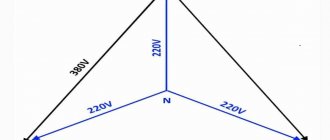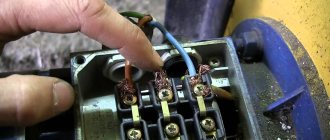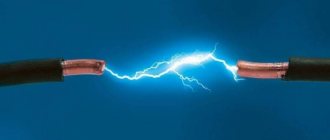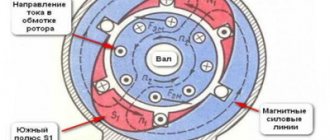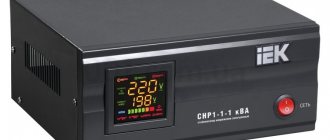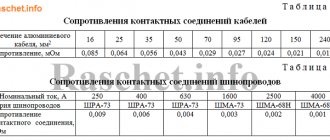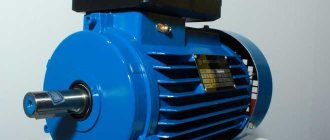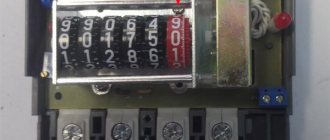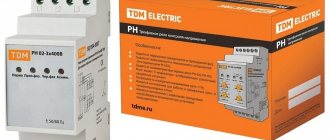How are three phases different from one?
In both types of power there is a working neutral conductor (ZERO). I talked in detail about protective grounding here; it is a broad topic. In relation to zero in all three phases - the voltage is 220 Volts. But in relation to these three phases to each other, they have 380 Volts.
Voltages in a three-phase system
This happens because the voltages (with active load, and current) on the three phase wires differ by a third of the cycle, i.e. at 120°.
You can read more in the electrical engineering textbook - about voltage and current in a three-phase network, and also see vector diagrams.
It turns out that if we have three-phase voltage, then we have three phase voltages of 220 V each. And single-phase consumers (and there are almost 100% of them in our homes) can be connected to any phase and zero. You just need to do this in such a way that the consumption in each phase is approximately the same, otherwise phase imbalance is possible.
Read more about phase imbalance and what causes it - here.
And it is best to protect yourself from phase imbalance using a voltage relay, for example Barrier or FiF EuroAutomatika.
In addition, it will be difficult for the overly loaded phase and it will be offensive that others are “resting”)
Measuring power with a wattmeter
The power consumption of three-phase current is measured using wattmeters. This can be a special wattmeter for a 3-phase network, or a single-phase one connected according to a specific circuit. Modern electricity metering devices are often made using digital circuitry. Such designs are characterized by high measurement accuracy and greater capabilities for operating with input and output data.
Three-phase digital wattmeter
Measurement options:
- Star connection with neutral conductor and symmetrical load - the measuring device is connected to one of the lines, the readings taken are multiplied by three.
- Asymmetrical current consumption in a star connection - three wattmeters in the circuit of each phase. The wattmeter readings are summed up;
- Any load and delta connection - two wattmeters connected in a circuit of any two loads. The wattmeter readings are also summed up.
Measurement schemes
In practice, they always try to make the load symmetrical. This, firstly, improves network parameters, and secondly, simplifies the accounting of electrical energy.
Advantages and disadvantages
Both power systems have their pros and cons, which change places or become insignificant when the power passes the 10 kW threshold. I'll try to list.
Single-phase network 220 V, advantages
- Simplicity
- Cheapness
- Below dangerous voltage
Single-phase network 220 V, cons
- Limited consumer power
Three-phase network 380 V, advantages
- Power is limited only by wire cross-section
- Savings with three-phase consumption
- Power supply for industrial equipment
- Possibility of switching a single-phase load to a “good” phase in case of deterioration in quality or power failure
Three-phase network 380 V, cons
- More expensive equipment
- More dangerous voltage
- Limits the maximum power of single-phase loads
Universal converter of single-phase current to three-phase.
Single-phase two-wire network
A single-phase network can be two- or three-wire. One of the signs of a two-wire electrical network is the use of aluminum conductors. In three-wire networks, in addition to the standard wires (phase and neutral), there is also a protective wire that performs the grounding function.
The use of a single-phase network circuit of this type allows for additional protection of home occupants from electric shock and prevents burnout of electrical appliances. The ground wire (PE) is connected to the housings of household appliances; as soon as a phase is shorted to the housing, the equipment is turned off.
In the construction of modern buildings, a connection to a single-phase network with three conductors is mainly used, much less often - with one.
What kind of lighting do you prefer?
Built-in Chandelier
When is it 380 and when is it 220?
So why do we have a voltage of 220 V in our apartments and not 380? The fact is that, as a rule, consumers with a power of less than 10 kW are connected to one phase. This means that one phase and a neutral (zero) conductor are introduced into the house. This is exactly what happens in 99% of apartments and houses.
Single-phase electrical panel in the house. The right machine is introductory, then through the rooms. Who can find mistakes in the photo? Although, this shield is one big mistake...
However, if you plan to consume power more than 10 kW, then a three-phase input is better. And if you have equipment with three-phase power supply (containing three-phase motors), then I strongly recommend introducing a three-phase input into the house with a linear voltage of 380 V. This will save on wire cross-section, on safety, and on electricity.
Three-phase input. Input machine for 100 A, then - to a three-phase direct connection meter Mercury 230.
Despite the fact that there are ways to connect a three-phase load to a single-phase network, such modifications sharply reduce the efficiency of motors, and sometimes, all other things being equal, you can pay 2 times more for 220 V than for 380.
Single-phase voltage is used in the private sector, where power consumption, as a rule, does not exceed 10 kW. In this case, a cable with wires with a cross section of 4-6 mm² is used at the input. The current consumption is limited by the input circuit breaker, the rated protection current of which is no more than 40 A.
I already wrote about choosing a circuit breaker here. And about the choice of wire cross-section - here. There are also heated discussions of issues.
But if the consumer’s power is 15 kW or higher, then three-phase power must be used. Even if there are no three-phase consumers in this building, for example, electric motors. In this case, the power is divided into phases, and the electrical equipment (input cable, switching) does not bear the same load as if the same power was taken from one phase.
An example of a three-phase electrical panel. Consumers are both three-phase and single-phase.
For example, if a house is powered by a single phase and consumes a power of 15 kW - this is a current of about 70A, you need a copper wire with a cross-section of at least 10 mm². The cost of a cable with such cores will be significant. But I have never seen single-phase (single-pole) circuit breakers with a current greater than 63 A on a DIN rail.
By the way, if you are interested in the VVG-ng-ls cable, I recommend visiting the website xcabel.ru. There you will find the widest range of different cables at the best prices.
Therefore, in offices, stores, and especially in enterprises, only three-phase power is used. And, accordingly, three-phase meters, which come in direct connection and transformer connection (with current transformers).
And at the input (in front of the counter) there are approximately the following “boxes”:
Three-phase input. Introductory machine in front of the counter.
A significant disadvantage of a three-phase input (noted above) is the limitation on the power of single-phase loads. For example, the allocated power of three-phase voltage is 15 kW. This means that for each phase - a maximum of 5 kW. This means that the maximum current in each phase is no more than 22 A (practically 25). And you have to spin, distributing the load.
I hope it is now clear what three-phase voltage 380 V and single-phase voltage 220 V are?
What is phase voltage?
In three-phase mains in most countries, the voltage is 220 volts. Phase voltage is measured in the gap between the phases at the beginning and end of the wire. In practice, this is the value in the middle of the neutral conductor and the stressed cable. When connected as a star, the values of line currents and phase electricity do not differ.
A symmetrical system eliminates the presence of a neutral core; with an asymmetrical method, the neutral cable maintains proportionality with the source. In the second option, lighting devices are often included in the circuit, and independent operation of 3 working cables is required, then the receiver terminals are combined in a triangle type.
Phase-to-phase voltage is used in the multi-apartment sector with shops or offices on the ground floors. This way you can power trading floors with power cables to provide 380 volts. In high-rise buildings, connection is provided by elevators, escalators, and industrial refrigerators. The wiring is relatively simple, given that the zero and live wires go into the housing, and 3 working cables and a neutral wire branch off to the public premises.
The difference between three-phase current and single-phase current is that the network indicator is linear power, and the parameters related to the load are phase voltage. A line is drawn from the station to the consumer, including working cores and a neutral wire. To reduce leakages when passing through the circuit, converters are installed at the beginning and end of the network, but this does not change the picture. The neutral wire fixes and transports to the user the declared potential obtained at the output. The power in the wire under load is created based on the value in the neutral.
The magnitude of the phase voltage is detected and occurs relative to the center of connection of the windings - the neutral wire. In a three-phase circuit that is symmetrical with respect to the loads, a current with minimal values is transmitted through zero. At the output of such a line, the wires under load are painted in generally accepted standard colors:
- core L1 - brown;
- wire L2 - black;
- cable L3 - gray;
- zero braid N - blue;
- yellow or green - provided for grounding.
Such powerful lines are carried out to large consumers - entire neighborhoods, factories. For small receivers, a single-phase line is installed, including a loaded wire and an additional zero. With an even distribution of power in single-phase branches, equilibrium appears in the three-phase design. To lay the component branches, the phase voltage of one core relative to the neutral is taken.
Star and Delta circuits in a three-phase network
There are various variations for connecting a load with an operating voltage of 220 and 380 Volts to a three-phase network. These patterns are called “Star” and “Triangle”.
When the load is designed for a voltage of 220V, it is connected to a three-phase network according to the “Star” circuit , that is, to phase voltage. In this case, all load groups are distributed so that the powers in the phases are approximately equal. The zeros of all groups are connected together and connected to the neutral wire of the three-phase input.
All our apartments and houses with single-phase input are connected to Zvezda; another example is the connection of heating elements in powerful heaters and convection ovens.
When the load has a voltage of 380V, it is switched on according to the “Triangle” circuit, that is, to linear voltage. This phase distribution is most typical for electric motors and other loads where all three parts of the load belong to a single device.
Why not 4, 5 or more phases?
Here the answer lies in economic feasibility. In Russia, the overwhelming amount of electricity is spent on operating three-phase motors. To create a rotating electromagnetic field, a minimum of 3 phases are required, each of which is shifted relative to the other by 120° (see figure below). If there are three phases, the motor will operate normally and stably.
In theory, you can connect 4 phases, which, by the way, will allow the engine to run more smoothly. But for the operation of the fourth phase, it will be necessary to lay additional wire, which on a national scale amounts to millions of tons of non-ferrous metal, additional insulators, reinforced supports, etc. All this incurs enormous costs, which in fact are not justified. So in this case, three phases are the “golden mean”.
So, three phases are REQUIRED to run three phase motors, but four, five or more are a waste of money.
Interesting things from the world of electrical engineering:
- Why is there 220 V between phase and zero, and 380 V between phases?
- How Europeans make money from solar energy: real experience
Power distribution system
Initially, the voltage is always three-phase. By “initially” I mean a generator at a power plant (thermal, gas, nuclear), from which a voltage of many thousands of volts is supplied to step-down transformers, which form several voltage stages. The last transformer lowers the voltage to a level of 0.4 kV and supplies it to end consumers - you and me, apartment buildings and the private residential sector.
Large enterprises with power consumption of more than 100 kW usually have their own 10/0.4 kV substations.
Visually:
Three-phase power supply – stages from generator to consumer
The figure shows in a simplified way how from generator G a voltage (everywhere we are talking about three-phase) 110 kV (can be 220 kV, 330 kV or another) is supplied to the first transformer substation TP1, which lowers the voltage for the first time to 10 kV. One such transformer substation is installed to power a city or region and can have a capacity of the order of a few to hundreds of megawatts (MW).
Next, the voltage is supplied to the second stage transformer TP2, at the output of which the end-user voltage is 0.4 kV (380V). The power of transformers TP2 is from hundreds to thousands of kW. From TP2, voltage is supplied to us - to several apartment buildings, to the private sector, etc.
Such voltage level conversion stages are necessary in order to reduce losses during the transportation of electricity. Read more about losses in cable lines in my other article.
The circuit is simplified, there may be several steps, the voltage and power may be different, but the essence does not change. There is only one final voltage of consumers - 380 V.
How does a generator work?
The device works by converting rotational energy into electrical energy. The electric machine, using the rotation of the MP, generates electric current. At the moment when the wire winding (coil) rotates in the MF, the magnetic field lines penetrate the turns of the winding.
Attention! As a result of this process, electrons move towards the positive pole of the magnet. In this case, the current moves, on the contrary, towards the negative magnetic pole
It doesn’t matter what rotates under mechanical action, a winding or a magnetic field, the current will flow as long as the rotation is performed. Generators producing three-phase voltage may have:
Generators producing three-phase voltage may have:
- fixed magnets and a movable (rotating) armature;
- a stationary stator and magnetic poles that rotate.
In devices of the first design, there is a need to draw a large current at a high voltage. To do this, you have to use brushes (contacts sliding along slip rings).
The second generator structure is simpler and more in demand. Here the rotor is a moving element and consists of magnetic poles. The stator is a stationary part, assembled from a package of iron sheets insulated with each other and inserted into the grooves of the stator winding.
Information. The rotor has a body made of solid iron and has magnetic poles in the form of tips. Tips are assembled from separate sheets. Their shape is selected so that the generated current is close to a sinusoid in shape.
Pole cores have field coils. The coils are supplied with direct current. The feed is carried out through graphite brushes to the contact rings located on the shaft.
In the diagrams, a 3-phase generator is drawn as three windings, the angle between which is 1200.
There are several ways to excite generators, namely:
- independent - using a battery;
- from the exciter - using an additional generator mounted on one shaft;
- due to self-excitation - its own rectified current.
This also includes magnetic excitation supplied from permanent magnets.
Three-phase alternator
Photo
Finally, a few more photos with comments.
Electrical panel with three-phase input, but all consumers are single-phase.
Three-phase input. Switch to a smaller cross-section of wires to connect them to the meter.
Friends, that’s all for today, good luck to everyone!
I look forward to your feedback and questions in the comments!

